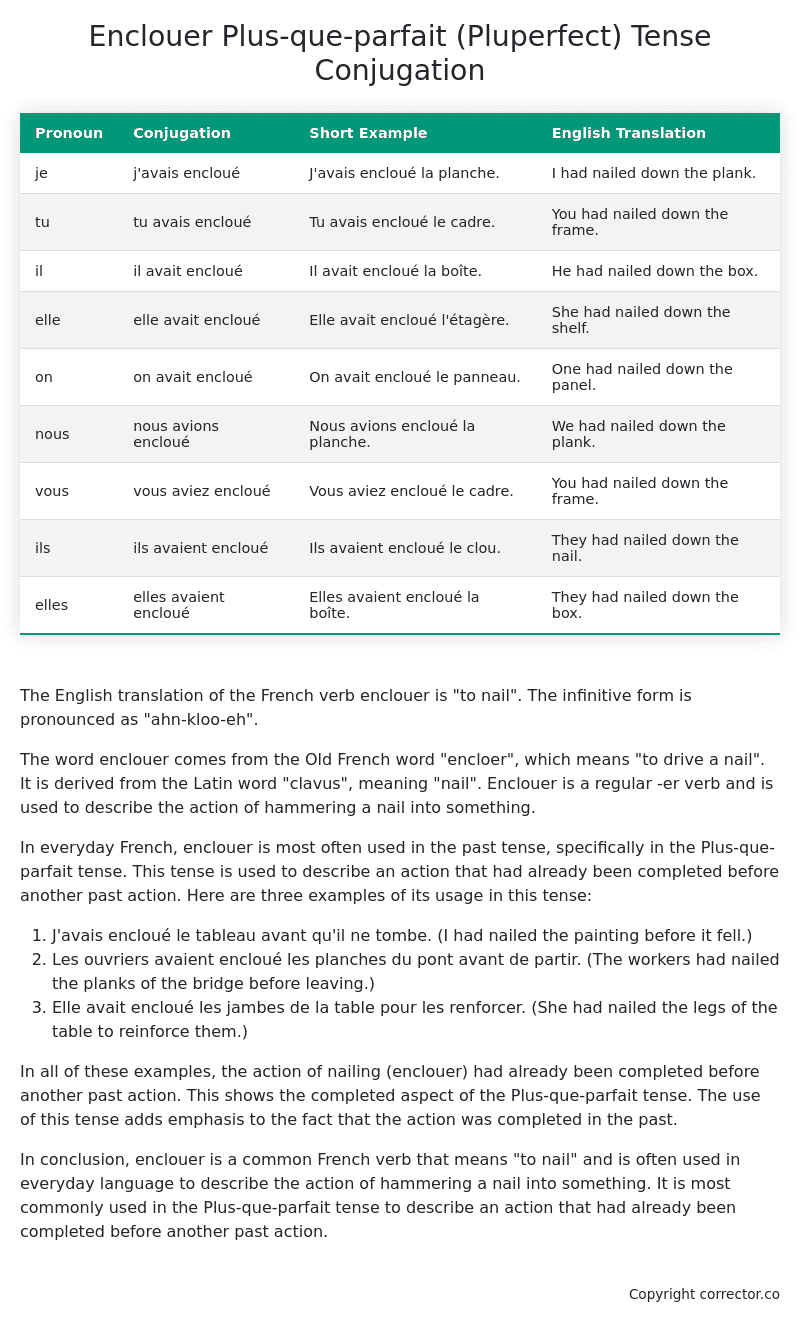Plus-que-parfait (Pluperfect) Tense Conjugation of the French Verb enclouer
Introduction to the verb enclouer
The English translation of the French verb enclouer is “to nail”. The infinitive form is pronounced as “ahn-kloo-eh”.
The word enclouer comes from the Old French word “encloer”, which means “to drive a nail”. It is derived from the Latin word “clavus”, meaning “nail”. Enclouer is a regular -er verb and is used to describe the action of hammering a nail into something.
In everyday French, enclouer is most often used in the past tense, specifically in the Plus-que-parfait tense. This tense is used to describe an action that had already been completed before another past action. Here are three examples of its usage in this tense:
- J’avais encloué le tableau avant qu’il ne tombe. (I had nailed the painting before it fell.)
- Les ouvriers avaient encloué les planches du pont avant de partir. (The workers had nailed the planks of the bridge before leaving.)
- Elle avait encloué les jambes de la table pour les renforcer. (She had nailed the legs of the table to reinforce them.)
In all of these examples, the action of nailing (enclouer) had already been completed before another past action. This shows the completed aspect of the Plus-que-parfait tense. The use of this tense adds emphasis to the fact that the action was completed in the past.
In conclusion, enclouer is a common French verb that means “to nail” and is often used in everyday language to describe the action of hammering a nail into something. It is most commonly used in the Plus-que-parfait tense to describe an action that had already been completed before another past action.
Table of the Plus-que-parfait (Pluperfect) Tense Conjugation of enclouer
| Pronoun | Conjugation | Short Example | English Translation |
|---|---|---|---|
| je | j’avais encloué | J’avais encloué la planche. | I had nailed down the plank. |
| tu | tu avais encloué | Tu avais encloué le cadre. | You had nailed down the frame. |
| il | il avait encloué | Il avait encloué la boîte. | He had nailed down the box. |
| elle | elle avait encloué | Elle avait encloué l’étagère. | She had nailed down the shelf. |
| on | on avait encloué | On avait encloué le panneau. | One had nailed down the panel. |
| nous | nous avions encloué | Nous avions encloué la planche. | We had nailed down the plank. |
| vous | vous aviez encloué | Vous aviez encloué le cadre. | You had nailed down the frame. |
| ils | ils avaient encloué | Ils avaient encloué le clou. | They had nailed down the nail. |
| elles | elles avaient encloué | Elles avaient encloué la boîte. | They had nailed down the box. |
Other Conjugations for Enclouer.
Le Present (Present Tense) Conjugation of the French Verb enclouer
Imparfait (Imperfect) Tense Conjugation of the French Verb enclouer
Passé Simple (Simple Past) Tense Conjugation of the French Verb enclouer
Passé Composé (Present Perfect) Tense Conjugation of the French Verb enclouer
Futur Simple (Simple Future) Tense Conjugation of the French Verb enclouer
Futur Proche (Near Future) Tense Conjugation of the French Verb enclouer
Plus-que-parfait (Pluperfect) Tense Conjugation of the French Verb enclouer (this article)
Passé Antérieur (Past Anterior) Tense Conjugation of the French Verb enclouer
Futur Antérieur (Future Anterior) Tense Conjugation of the French Verb enclouer
Subjonctif Présent (Subjunctive Present) Tense Conjugation of the French Verb enclouer
Subjonctif Passé (Subjunctive Past) Tense Conjugation of the French Verb enclouer
Subjonctif Imparfait (Subjunctive Imperfect) Tense Conjugation of the French Verb enclouer
Subjonctif Plus-que-parfait (Subjunctive Pluperfect) Tense Conjugation of the French Verb enclouer
Conditionnel Présent (Conditional Present) Tense Conjugation of the French Verb enclouer
Conditionnel Passé (Conditional Past) Tense Conjugation of the French Verb enclouer
L’impératif Présent (Imperative Present) Tense Conjugation of the French Verb enclouer
L’infinitif Présent (Infinitive Present) Tense Conjugation of the French Verb enclouer
Struggling with French verbs or the language in general? Why not use our free French Grammar Checker – no registration required!
Get a FREE Download Study Sheet of this Conjugation 🔥
Simply right click the image below, click “save image” and get your free reference for the enclouer Plus-que-parfait tense conjugation!

Enclouer – About the French Plus-que-parfait (Pluperfect) Tense
Tense Formation
Common everyday usage patterns
Sequencing of past events
Background information
Hypothetical or reported speech
Interactions with other tenses
Summary
I hope you enjoyed this article on the verb enclouer. Still in a learning mood? Check out another TOTALLY random French verb conjugation!


